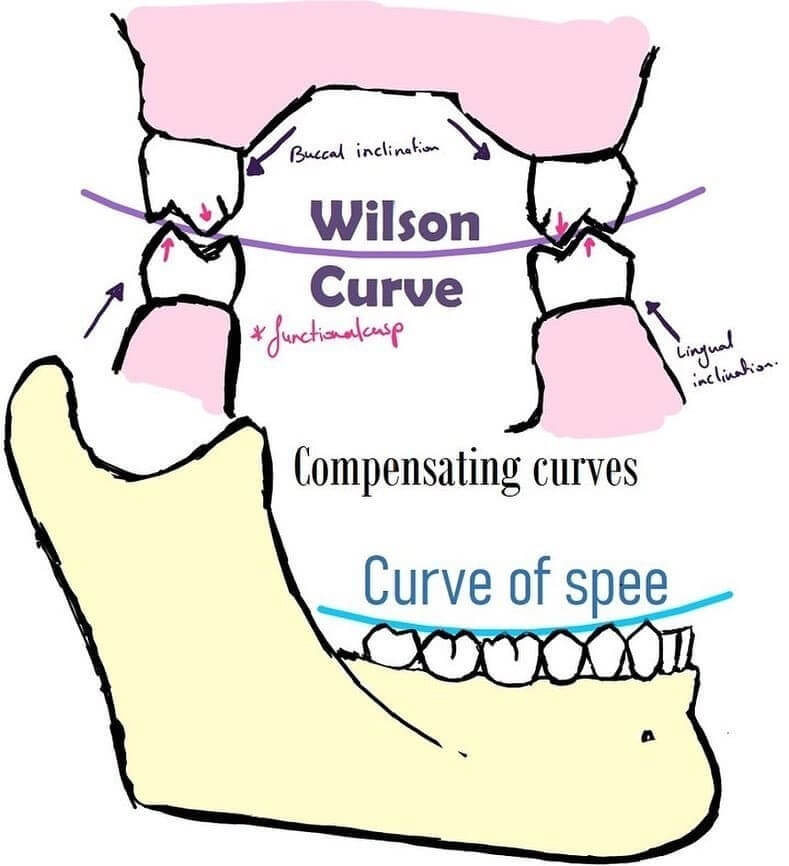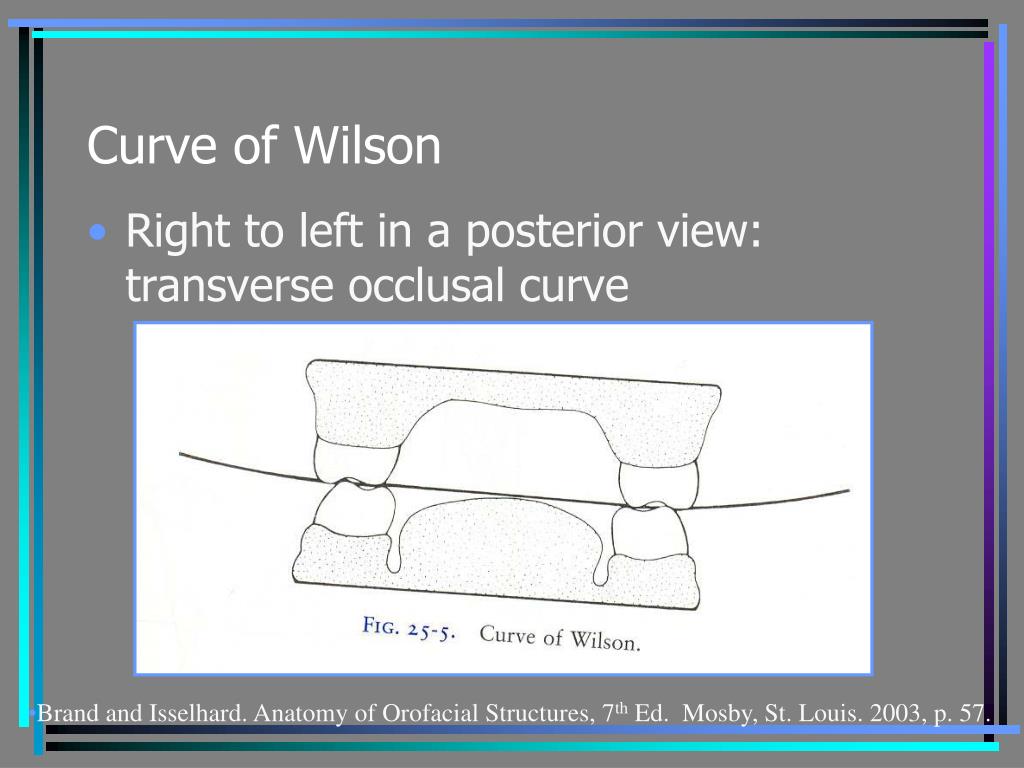Does the seemingly simple act of chewing involve a complex interplay of curves and planes, shapes that determine the very functionality of our bite? Indeed, the intricate geometry of our teeth, specifically the curves of Spee and Wilson, are fundamental to a healthy and efficient occlusion, shaping the way we eat and even speak.
The study of occlusion, the contact relationship between the upper and lower teeth, extends beyond mere aesthetics. It delves into the precise arrangement of teeth, their individual forms, and how they interact during various jaw movements. A key concept revolves around the idea of a spherical occlusion, which posits that the ideal arrangement of teeth follows a spherical shape. This is where the curves of Spee and Wilson come into play.
Let's delve into the specifics, consider the following data on the intricacies of occlusion and its related curves, these are based on findings from dental research:
| Feature | Description | Relevance |
|---|---|---|
| Curve of Spee | Anteroposterior curve; a curve formed by the occlusal surfaces of the posterior teeth, running from the canine to the second molar. | Essential for protrusive movements; allows for posterior teeth disocclusion during forward jaw movement. |
| Curve of Wilson | Mediolateral curve; a curve that reflects the inclination of the teeth in the transverse plane. It is the curvature of the occlusal surfaces, for example, of teeth 36 and 46. | Facilitates lateral excursions of the mandible; ensures balanced contact between teeth during side-to-side movements. |
| Monson's Curve | A three-dimensional curve that takes into account both the anteroposterior and mediolateral curves. | The curve is a component of a larger sphere and is often referenced when determining the normal occlusal plane in dental treatments. |
| Occlusal Plane | The plane formed by the occlusal surfaces of the teeth. | Determining the occlusal plane is crucial for orthodontic treatments. |
| Maximum and Central Occlusion | Maximum occlusion is the point of maximum intercuspation (the teeth fitting together best) of the upper and lower teeth, while central occlusion is the position of the mandible when the condyles are in their most superior position in the glenoid fossae. | When these two coincide, there is even distribution of forces and less chance of teeth migrating and issues occurring. |
| Radii of Curvature | Measurements of the curves of Spee and Wilson. | In adults, the radii of the curves can be measured, providing a baseline for comparison. |
| Inclination of Teeth | The tilting of the teeth. | Molars of the lower jaw are inclined lingually, and those of the upper jaw are inclined buccally. |
| Lingual and Buccal Cusps | The pointed or rounded parts of the teeth. | The lingual cusps of the lower molars are lower than the buccal cusps, and the buccal cusps of the upper molars are higher. |
| Protrusion | The forward movement of the mandible. | Permitted by the curve of Spee. |
References for further reading can be found at: National Center for Biotechnology Information (NCBI).
The curve of Wilson, named after the British orthodontist George H. Wilson, specifically describes the mediolateral curvature of the occlusal plane. Imagine a line drawn across the occlusal surfaces of the molar teeth from one side of the jaw to the other. This line, in a normal occlusion, exhibits a curve. This curve is convex in the upper jaw (maxilla) and concave in the lower jaw (mandible). The inclination of the teeth is the key here: the lower molars tend to tilt inwards (lingually), making their lingual cusps lower, while the upper molars often tilt outwards (buccally), resulting in their buccal cusps being higher. The interaction of these angled teeth is what creates the Wilson curve.
The curve of Spee, on the other hand, runs anteroposteriorly, meaning it follows the line of the dental arch from front to back. This curve is formed by the occlusal surfaces of the posterior teeth, creating a natural arc. This arch can vary in individuals, the mean radius of the curve of Spee was 106.4 mm in the maxilla and 83.4 mm in the mandible.
- Logan Pauls Charizard Saga From Nft Investment To Internet Sensation
- Discover Alluring Images Of Clauddine Blanchard
The presence of these curves is not merely a matter of chance. They contribute to the overall stability and function of the bite. When the teeth are correctly aligned along the curves of Spee and Wilson, they provide a more even distribution of forces during chewing. This reduces the stress on individual teeth, minimizing the risk of damage, wear, and migration. Furthermore, the curves facilitate the complex movements of the mandible, such as opening and closing, and side-to-side (lateral) excursions. The interplay between anterior guidance (the influence of the front teeth) and condylar guidance (the movement of the jaw joints) is another factor that impacts disocclusion.
The shape of the teeth and their arrangement give rise to these curves. Moreover, these curves are crucial to allowing the lower jaw to move easily relative to the upper jaw. The shape and positioning of these elements are the basis of the transverse curve, where lingual tubercles are anatomically more important than buccal tubercles in the upper molar.
In dental treatments, particularly in orthodontics, understanding and restoring the natural curves of Spee and Wilson are essential. These curves are a reference point when determining the occlusal plane, a plane that is crucial to treatments. When the teeth are not properly aligned along these curves, a variety of problems can arise, ranging from difficulty in chewing to temporomandibular joint (TMJ) disorders. The absence of these curves and the lack of proper occlusion can also lead to the migration of the teeth.
A thorough understanding of occlusion is crucial, as these concepts apply to patients undergoing orthodontic treatment and other dental procedures. The goal of the treatment is to ensure the teeth are in contact with each other in both maximum occlusion, at the point of maximum intercuspation, and central occlusion, in such a way as to distribute the forces evenly among the opposing teeth.
The importance of these curves extends beyond the purely physical aspects of the mouth. The way we chew, the way we speak, and the overall aesthetic of our smile are all influenced by the presence and alignment of the curves of Spee and Wilson. These features of occlusion are the key to functional and esthetic dentition and are central to any dental treatment.
The curve of Spee is designed to permit protrusive disocclusion of the posterior teeth by the combination of anterior guidance and condylar guidance, and the curve of wilson also permits lateral mandibular excursions free. Protrusion is when the mandible moves forward, and this movement is enabled by the arrangement of the teeth. Likewise, the curve of Wilson is not from ventral to dorsal but a cross-section of m1s frontal, which is the curve in transverse plane.
The curve of Wilson, as a transverse curve, runs from buccal to lingual. The curve of Spee is a sagittal curve, from mesial to distal. The arrangement and shape of the teeth also play a major role.
The concepts of occlusion and dental anatomy are always evolving, with new research and treatment techniques constantly emerging. However, the fundamental principles established by pioneers like George H. Wilson and the continued refinement of these concepts remain the foundation of successful dental treatment. Modern dentistry applies these concepts for the overall oral health and quality of life of patients.
Even though the term "Curve of Wilson" has found itself in the automotive and commercial transportation industries, denoting qualities like innovation, versatility, and efficiency, it's worth emphasizing its original and primary importance in dental science. The term refers to the curvature of the posterior occlusal plane, crucial to a functional and healthy bite.
Understanding the interplay between the curves of Spee and Wilson provides an insight into the remarkable mechanics of the human mouth. Their presence is essential to chewing, speaking, and a healthy and comfortable bite. These subtle curves, often overlooked, play a significant role in ensuring the harmonious function and overall well-being of our oral health. The focus on these curves also allows for more natural movement of the jaw relative to the teeth.
The study of occlusion is an ongoing field, as researchers continue to investigate and refine our understanding of the complex interactions that take place within the mouth. However, the importance of these principles in a functional and esthetic dentition remains paramount, regardless of any advancements in techniques or technology.



Detail Author:
- Name : Prof. Gail Keeling
- Username : kpaucek
- Email : zwitting@schmeler.com
- Birthdate : 1984-06-13
- Address : 977 Marlee Underpass Suite 354 Lake Marielashire, NY 33512-9865
- Phone : +1-812-407-7125
- Company : Jones-Cartwright
- Job : Packaging Machine Operator
- Bio : Dolores aut consequatur est. Quaerat nostrum blanditiis facere deleniti esse esse et. Sint occaecati temporibus sed laudantium. Provident repellendus voluptatibus et eum necessitatibus illo.
Socials
linkedin:
- url : https://linkedin.com/in/kaylie2384
- username : kaylie2384
- bio : Recusandae amet cumque et odio dicta iste.
- followers : 1755
- following : 2417
tiktok:
- url : https://tiktok.com/@kaylie_weimann
- username : kaylie_weimann
- bio : Ut doloribus nihil eos voluptatem.
- followers : 4243
- following : 910
facebook:
- url : https://facebook.com/weimannk
- username : weimannk
- bio : Ut dolor nobis velit tempora excepturi.
- followers : 480
- following : 456